Although officials say diplomacy is still possible, the re-imposition of sanctions effectively ends the 2015 nuclear deal that U.S. President Donald Trump unilaterally abandoned in 2018.
October 2025
By Kelsey Davenport
Iran said it would suspend cooperation with the International Atomic Energy Agency (IAEA) after the UN Security Council reimposed sanctions and restrictions on Tehran’s nuclear and missile programs. But details were unclear.
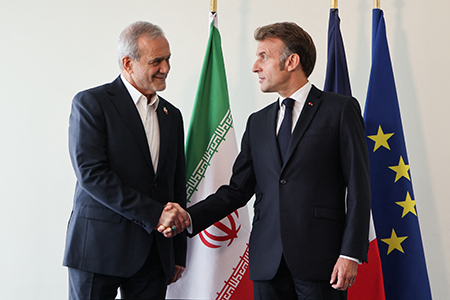
Iranian President Masoud Pezeshkian told reporters Sept. 26 that the reimposition of sanctions was “unfair, unjust, and illegal.” After the measures were reimposed, he said in a Sept. 29 speech that Iran will not “bow down” to sanctions pressure.
The Security Council decision came a decade after a landmark international agreement called the Joint Comprehensive Plan of Action (JCPOA) imposed tight controls on Iran’s nuclear programs in return for a lifting of sanctions. In 2018, U.S. President Donald Trump unilaterally abandoned the agreement. Iran initially complied with its commitments but eventually resumed prohibited activities. In addition to the United States, other parties to the deal were China, Russia, France, Germany and the United Kingdom.
During the Sept. 26 press conference, Pezeshkian said that Iran will not leave the nuclear Nonproliferation Treaty (NPT) in response to the reimposition. But Iran said it would suspend a Sept. 9 arrangement that Foreign Minister Abbas Araghchi reached with the IAEA to restart cooperation, after Iran suspended safeguards following the Israeli and U.S. strikes on its nuclear facilities in June. Iran is legally required to implement a safeguards agreement as an NPT member.
The reimposition of UN Security Council resolutions on Iran from 2006 to 2010 took effect Sept. 28 as expected, 30 days after a request from France, Germany, and the United Kingdom—known as the E3—to restore the measures. They cited Iran’s violations of the 2015 nuclear deal as the reason for reimposition. (See ACT, September 2025.)
U.S. Secretary of State Marco Rubio said in a Sept. 27 statement that the reimposition of sanctions sends “a clear message” that Iran will be “held to account.” He said that “diplomacy is still an option” but “Iran must accept direct talks.”
In addition to sanctions, the Security Council resolutions restore prohibitions on Iranian nuclear activities—including uranium enrichment and missile development—that were lifted by Security Council Resolution 2231, which endorsed the JCPOA.
The three European countries were able to reimpose the previous resolutions using a unique mechanism contained in Resolution 2231, known as “snapback,” that cannot be blocked.
In a Sept. 19 Security Council vote to extend the JCPOA, only Algeria, China, Pakistan, and Russia voted in favor of the measure. The Security Council needed to pass that resolution to prevent the reimposition of the previous resolutions.
The E3 said in a Sept. 28 statement that they “made every effort” to avoid snapback and that “Iran did not engage seriously” with their offer to extend snapback in exchange for Iran’s commitment to resume talks with the United States, meet its IAEA safeguards obligations, and address its highly enriched uranium stockpiles. The E3 urged all states to implement the reimposed sanctions.
In a Sept. 26 press briefing, Araghchi said Iran showed “good faith by presenting good and doable proposals which could have resolved this problem,” but Iran’s “diplomacy has been blocked.” He suggested that Iran and France made progress on a framework that could have extended snapback, but France was “unable to secure the approval of the United States.”
Araghchi did not present specifics on Iran’s proposal, but he referenced an agreement he signed with IAEA Director-General Rafael Mariano Grossi in Cairo Sept. 9 as a sign of Tehran’s willingness to engage. The text of the Cairo agreement was not made public, and Araghchi and Grossi offered slightly different descriptions of what it contained.
Araghchi told Iranian state TV Sept. 10 that “the nature of [IAEA] access will have to be discussed at an appropriate time” and will be “based on reports that Iran will issue.”
Grossi said the Cairo agreement provided a “clear understanding of the procedures for inspections.” He said it was “fully in line with the relevant provisions” of Iran’s comprehensive safeguards agreement.
The Europeans suggested the agreement was insufficient because it did not include specific timelines for accessing nuclear sites in Iran that were attacked by Israel and the United States. The IAEA has had access to Iran’s Bushehr nuclear power reactor and the Tehran Research Reactor, neither of which were targeted by U.S. and Israeli strikes.
The Europeans also sought information on the status of Iran’s stockpile of uranium-235 enriched to 60 percent. According to a Sept. 3 IAEA report, Iran had 441 kilograms of uranium enriched to that level before the June 13 strikes. Iran likely moved the material to the underground facility at Esfahan that was too deeply buried to be destroyed by U.S. strikes. The entrance to that facility was struck, however, rendering the material inaccessible. (See ACT, July/August 2025.)
Araghchi told the state-run IRIB News Agency in a Sept. 11 interview that the Atomic Energy Organization of Iran is evaluating “whether these materials are accessible or not, and the status of some of them.”
Pezeshkian said Iran was willing to talk to the E3 and the United States at the United Nations, but U.S. officials did not show up for the meeting. He suggested that Iran had reached “understandings” with the Europeans, but the United States rejected the progress.
U.S. Special Envoy Steve Witkoff told reporters Sept. 24 that “we’re talking to [Iran]” but did not specify if he had met with Iranian officials. U.S. Energy Secretary Chris Wright told the IAEA Sept. 15 that the United States is still interested in reaching an agreement with Iran, but “Iran’s nuclear weapons pathway, including all enrichment and reprocessing capabilities, must be completely dismantled.”
Although the United States and Israel struck Iran’s two uranium enrichment facilities, a report from Le Monde suggested that Israeli intelligence assessed that Iran retains the capabilities to restart uranium enrichment. Iran says it will not agree to give up uranium enrichment as part of any deal.
The Kremlin’s proposal offered some hope but the United States had no immediate formal reaction.
October 2025
By Xiaodon Liang
Russia is “prepared to continue observing the … central quantitative restrictions” of the 2010 New Strategic Arms Reduction Treaty (New START) for one year after its expiration if the United States “acts in a similar spirit,” Russian President Vladimir Putin announced at a Sept. 22 Russian Security Council meeting.
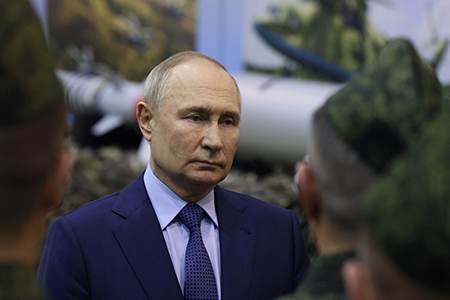
New START, which limits U.S. and Russian nuclear forces to 1,550 strategic warheads and 700 strategic launchers deployed on each side, will expire Feb. 5, 2026. In 2021, the United States and Russia agreed to exercise a clause of the treaty permitting a one-time, five-year extension.
Speaking at a Sept. 22 news conference, White House Press Secretary Karoline Leavitt said the proposal sounded “pretty good.” Two weeks later, President Donald Trump, answering a question from a TASS reporter, affirmed the U.S. view, saying of Putin’s proposal, “it sounds like a good idea to me.”
U.S. Secretary of State Marco Rubio met with Russian Foreign Minister Sergey Lavrov Sept. 24 in New York on the sidelines of the United Nations General Assembly meeting. Although the two sides “compared their positions on the entire bilateral agenda,” according to the Russian statement summarizing the meeting, no progress was announced on arms control.
In extending the Sept. 22 offer, Putin said “a complete renunciation of New START’s legacy would, from many points, be a grave and short-sighted mistake” with “adverse implications for the objectives of the [nuclear Nonproliferation Treaty].”
Following the proposed one-year extension, Russia would make “a careful assessment of the situation [and] a definite decision on whether to uphold these voluntary self-limitations,” Putin said.
In his remarks, Putin did not say that an agreement, explicit or tacit—or even a U.S. announcement—was required before Russia would adopt its unilateral freeze. The measure would not be viable, however, if the United States takes “steps that would undermine or disrupt the existing balance of deterrence,” Putin said.
The Russian leader specifically named U.S. “preparations for the deployment of [missile defense] interceptors in outer space” as a step that could destabilize the strategic balance. (See ACT, September 2025.) Russia previously stated its concerns about the Trump administration’s plans for a comprehensive missile defense system, known as Golden Dome, in a May 8 joint statement with China. (See ACT, June 2025.)
A Chinese foreign ministry spokesman said Sept. 23 that his country “commends the positive stance” taken by Putin, before reiterating China’s standard rejection of Trump’s call for Beijing to take part in arms control negotiations alongside Moscow and Washington before the latter two make further substantial reductions in their arsenals.
Although Trump has not responded in public to the Russian proposal, he once again aired his skepticism of nuclear weapons in a Sept. 23 speech before the UN General Assembly.
“We want to have a cessation of the development of nuclear weapons,” the president said, noting that U.S. nuclear weapons “are so powerful that we just can’t ever use them.”
“If we ever use them, the world might literally come to an end,” he said.
But Trump has also previously said arms control talks with Russia might come only after the termination of the Russian full-scale invasion of Ukraine. (See ACT, September 2025.)
In a rhetorical shift following a Sept. 23 meeting with Ukrainian President Volodymyr Zelenskyy on the sidelines of the General Assembly, Trump said in a social media post that he believed Ukraine could restore its pre-2014 borders.
Although the president stopped short of offering further direct U.S. support for the Ukrainian war effort, he said the United States “will continue to supply weapons to NATO for NATO to do what they want with them.”
Zelenskyy, in his meeting with Trump, requested that the United States provide Ukraine with Tomahawk cruise missiles, The Telegraph reported Sept. 26. The Ukrainian leader confirmed at a Sept. 27 press conference that Ukrainian military experts would visit the United States in the coming weeks to negotiate a package of arms sales, valued close to $90 billion, that would be part of a post-conflict peace settlement.
The alliance responded to an incursion at an unprecedented scale since the start of Russia’s full-scale invasion of Ukraine in 2022.
October 2025
By Xiaodon Liang
NATO forces shot down Russian drones over Poland Sept. 10, responding to an incursion at a scale unprecedented since the start of Russia’s full-scale invasion of Ukraine in February 2022.
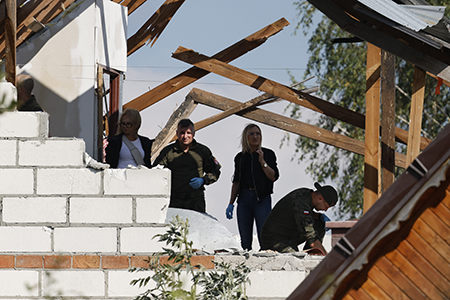
Twenty-one drones were detected in Polish airspace, flying primarily out of Belarus, according to Polish Prime Minister Donald Tusk. Polish and Dutch aircraft responded by shooting down at least three of the unmanned aircraft. No casualties have been reported in Poland, although falling debris—likely from a NATO air-to-air interceptor—damaged a house near Lublin.
Russian officials denied targeting the territory of Poland and implied that drones used in the war against Ukraine do not have the range to reach Polish targets.
But visual analysis of debris by multiple media outlets and Polish authorities confirm the aircraft are of Russian origin, likely Gerbera-type drones that can be equipped either as decoys or with explosive charges. The Gerbera is a derivative of the Iranian Shahed-136, which Tehran has supplied to Moscow in support of the latter’s war effort.
The chief of the general staff of Belarus’s military, Pavel Muraveiko, blamed the drone incursion on jamming by Russia and Ukraine. He claimed Belarusian forces had downed some stray drones before they reached Poland, and that his forces had exchanged information with Polish and Lithuanian counterparts.
NATO Secretary General Mark Rutte said the incursion was “reckless” and “unacceptable” regardless of Russian intentions, speaking Sept. 12 at a press conference.
The “Kremlin wanted to test the readiness of NATO allies,” Polish Foreign Minister Radoslaw Sikorski said Sept. 17 in a comment to Newsweek.
A joint statement issued Sept. 12 by Sikorski and his Lithuanian and Ukrainian counterparts directly accused Russia of a “deliberate and coordinated strike constituting an unprecedented provocation and escalation of tension.”
The drone incursion marked one of several Russian violations of NATO airspace in September. Three Russian MiG-31 combat aircraft entered Estonian airspace for 12 minutes in transit Sept. 20 toward Kaliningrad, and a sole Russian drone breached Romanian airspace Sept. 13, marking the eleventh similar incident according to data provided by the Romanian Ministry of Defense to ABC News. Individual Russian drones also have entered Polish airspace since the beginning of the Russian-Ukrainian war, the Polish Ministry of Defense noted Sept. 10.
Poland and Estonia requested consultations with NATO allies through invocation of Article 4 of the Washington Treaty, NATO’s founding agreement. On Sept. 12, Rutte and the supreme allied commander in Europe, Gen. Alexus Grynkewich, announced a new air defense mission for the alliance’s eastern flank, named Eastern Sentry.
According to Grynkewich, the new mission constitutes a “comprehensive and integrated approach” to air defense that would make it easier for NATO “to plug gaps in the line” where and when needed.
Invocations of Article 4 are rare but have increased since Russia seized Crimea in 2014. The last invocation of the treaty measure came in February 2022, after the beginning of Russia’s full-scale invasion.
At Poland’s request, the UN Security Council convened Sept. 12 to discuss the mass drone incursion.
The GAO finding calls into question previous statements by U.S. Air Force officials that the missile’s service life could not be extended.
October 2025
By Xiaodon Liang
The U.S. Air Force’s program office for the Minuteman III intercontinental ballistic missile (ICBM) has concluded that the strategic delivery system can remain in service through 2050, according to a Sept. 10 report by the Government Accountability Office (GAO).
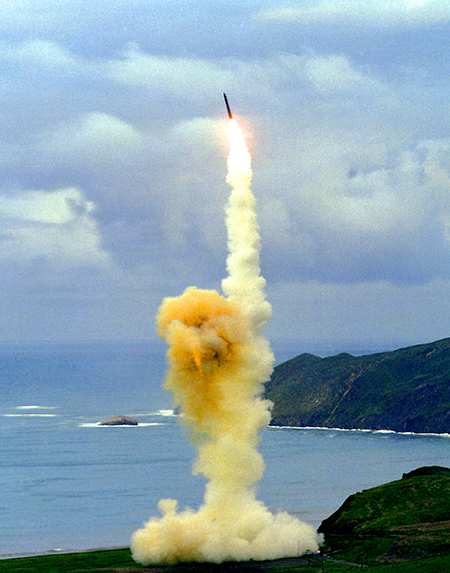
That finding calls into question previous statements by Air Force officials that the service life of the missile could not be further extended. In 2021, the head of Strategic Command, Adm. Charles Richard, said there was “no more margin” to keep the Minuteman III in service.
The new GAO study, which is an unclassified version of an April 2025 report to Congress, says Air Force officials informed GAO that they now “are confident that Minuteman III can be used beyond 2030, even out to 2050.”
But those officials also acknowledged certain “unknowns such as ground electrical subsystems and electronics—for example, diodes, resistors, and capacitors—which could degrade to unacceptable levels.”
The report concluded that the Air Force has not “developed a risk management plan [for the transition from Minuteman III to Sentinel] or other risk management tools consistent with leading project management practices.”
The Sentinel ICBM was scheduled to begin deployment in 2029 and completely replace all 400 existing Minuteman III missiles by 2036. But a large increase in the projected costs of the Sentinel program forced the Air Force to reassess its plans, potentially adding several years of delay. (See ACT, September 2024.)
The GAO said that the Pentagon’s internal study of the large cost projection increase—mandated by cost control provisions of the Nunn-McCurdy Act—attributed the unanticipated problems to an unrealistic delivery schedule, ineffective systems engineering, and an incomplete basic system design, as well as an “atrophied” ICBM industrial base.
“Continuing to sink billions into a program that is behind schedule, over budget, and unproven when the existing program could last 25 more years is a waste of taxpayer dollars,” said Rep. John Garamendi (D-Calif.), a critic of the Sentinel program in a statement to Arms Control Today. In March 2024, Garamendi and Sen. Elizabeth Warren (D-Mass.) asked the Air Force to study the possibility of life-extending Minuteman III to 2030, 2040, or 2050.
A senior Air Force official claims that a new plan, finalized this summer to dig fresh silos for the Sentinel missile rather than reuse Minuteman III missile silos would speed up deployment and bring the Sentinel back toward its original deployment schedule.
Speaking at the Mitchell Institute Aug. 27, Lt. Gen. Andrew Gebara, the Air Force’s deputy chief of staff for strategic deterrence and nuclear integration, argued that, because building new silos would not require rotating Minuteman III missiles off-duty, more could be built at once and construction would therefore be more efficient.
The Air Force has argued that a full life-extension program for the Minuteman III would not be cost effective. Those arguments, however, hinged on the assumptions that an ICBM force would have to remain in service through 2075 and that a life-extension program would have to make significant replacements of major components of the missile system.
Last July, Gebara said the Pentagon had studied a service life-extension program for the Minuteman III as part of its mandatory review of the Sentinel following the Nunn-McCurdy breach.
“A long-term [service life-extension program] still does not make sense for Minuteman,” but “what is going to happen is Minuteman sustainment to keep it viable until Sentinel is delivered,” he said.
Air Force officials responsible for Minuteman III sustainment met in February to assess “end of life 2050” challenges, Bloomberg reported in March. The GAO now says the Minuteman III program will request funding for sustainment of launch facilities in forthcoming budget requests.
The report also revealed that Air Force Global Strike Command has already shifted the majority of non-deployed launch facilities to F.E. Warren Air Force Base in Wyoming, whereas previously they were spread across the three U.S. ICBM bases. To comply with the numerical caps of the New Strategic Arms Reduction Treaty, the United States keeps 50 non-deployed ICBM silos in a warm reserve status.
The Air Force confirmed that one Minuteman III silo at F.E. Warren Air Force Base had been taken offline recently as part of the transition to Sentinel, Breaking Defense reported Sept. 3.
According to the GAO report, the base’s 90th Missile Wing transferred control of a non-deployed launch facility to Global Strike Command’s Site Activation Task Force in April 2025 so that the task force could “validate work concepts” to provide information for the transition to Sentinel.
The weaponry, at a parade commemorating the 80th anniversary of the end of World War II, showcased China’s rapidly modernizing military power.
October 2025
By Shizuka Kuramitsu
China displayed its rapidly modernizing military power at a parade commemorating the 80th anniversary of the end of World War II, including unveiling its land-, sea-, and air-based nuclear triad for the first time.
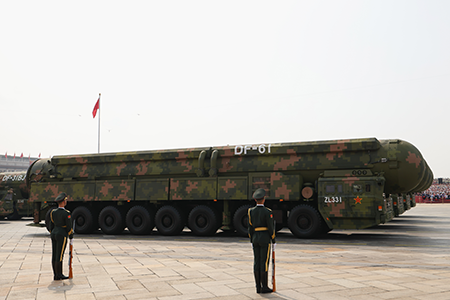
The military parade in Beijing Sept. 3 was meant to “mark the hard-won victory in the Chinese People’s War of Resistance against Japanese Aggression and the World Anti-Fascist War,” according to the state Xinhua News Agency. It aimed to pledge “the country’s commitment to peaceful development in a world still fraught with turbulence and uncertainties,” the news outlet reported.
At the parade, China revealed one new intercontinental ballistic missile, the Dongfeng-61. This new missile was grouped with other nuclear systems—such as the Dongfeng-31-BJ ICBM; the sea-launched ballistic missile, Julang-3; and the air-launched ballistic missile, Jinglei-1—suggesting that the DF-61 is also nuclear, according to a Sept. 4 analysis by Hans Kristensen, Eliana Johns, Matt Korda, and Mackenzie Knight-Boyle of the Federation of American Scientists.
“Although only one of the nuclear weapons presented at the parade was entirely new (the DF-61 ICBM), that and the many other systems displayed in this and previous parades—combined with the construction of three large missile silo fields and so far more than a tripling of the nuclear warhead stockpile—vividly illustrate the significant modernization and buildup of nuclear forces that China has undertaken over the past couple of decades,” the federation team wrote.
Despite the public display of the DF-61 missile, it remains unclear how different it is from the existing Dongfeng-41 ICBM, according to the federation team report and Etienne Marcuz, associate fellow at the Foundation for Strategic Research, who commented Sept. 3 on X.
“Based on new information from the parade footage, it seems China now has nine different versions of land-based ICBMs: DF-5A, DF-5B, DF-5C, DF-27 (not yet displayed in public), DF-31A, DF-31AG, DF-31BJ, DF-41, and DF-61,” according to the FAS team.
The researchers said that the displayed buildup of nuclear forces “appears to contradict China’s obligations under the nuclear Nonproliferation Treaty and risks stimulating nuclear buildups in the United States and India—developments that would not be in China’s interest.”
Along with the land component, the Julang-3 and Jinglei-1 were displayed, marking the first-time that China has collectively showcased its full nuclear triad.
It also marked the first time that China displayed a nuclear weapons system for delivery by aircraft, the Jinglei-1, which was described by the official parade commentator as an “air-based long-range missile,” according to the FAS report. “This is likely the air-launched ballistic missile (designated CH-AS-X-13 by the [U.S. Department of Defense]) that the Chinese air force has been working on for several years to integrate on the H-6N intermediate-range bomber. The first bomber base to be equipped for the nuclear mission is thought to be Neixiang air base in Henan province,” added the FAS report.
According to the Sept. 3 Xinhua report, “Representatives … from countries such as Russia, the United States, the United Kingdom, France, and Canada” were invited to the event, which Chinese President Xi Jinping, Russian President Vladimir Putin, North Korean leader Kim Jong Un, and more than 20 other foreign leaders attended.
China’s People’s Liberation Army Rocket Force is responsible for overseeing the country’s conventional and nuclear land-based missiles. In 2023, the rocket force had several cases of corruption scandals that resulted in a large-scale purge. (See ACT, March 2023.) According to the Chinese-language Singaporean newspaper Lianhe Zaobao, Chinese media revealed Sept. 11 that the purge was a result of a nine-year-long investigation.
The investigation found that “procurement brokers with expert identities and state-owned enterprises that engaged in bid rigging, and their qualifications have been terminated,” the newspaper reported.
Leader Kim Jong Un said he is open to talks if Washington drops its demand for denuclearization.
October 2025
By Kelsey Davenport
North Korean leader Kim Jong Un rejected dialogue with South Korea, but said he was open to talks with President Donald Trump if the United States drops its demand for denuclearization.
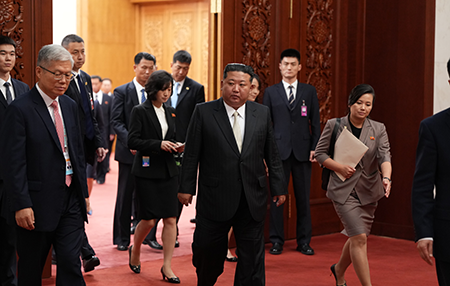
Kim told North Korea’s parliament in a Sept. 21 speech that the country will “never ever” give up its nuclear weapons but will discuss “genuine peaceful coexistence” with the United States, according to a transcript published by the state-run Korean Central News Agency.
South Korean President Lee Jae-Myung suggested that Seoul would support talks aimed at freezing Pyongyang’s nuclear weapons program as an interim measure. Lee, speaking to BBC North Korea on Sept. 22, said South Korea cannot “give up on the long-term goal of [North Korean] denuclearization” but he acknowledged that a freeze would be a “feasible, realistic alternative” for now.
Lee first outlined a three-stage plan for denuclearization in August, beginning with a freeze. His administration provided more detail on its approach to North Korea in a Sept. 16 policy document. That document called for “institutionalizing peaceful coexistence” with North Korea.
Prior to releasing the new strategy, Lee met Trump in Washington at the White House. During their Aug. 26 press conference, Lee urged Trump to act as a “peacemaker” on the Korean peninsula. He said Trump is the “only person that can make progress” on resolving the North Korean nuclear weapons threat.
Trump expressed interest in holding another summit meeting with Kim “this year” and said he and Kim will “make relations better.”
It is unclear, however, if Trump would be willing to move away from denuclearization in order to engage Kim.
Trump met Kim three times during Trump’s first term. At the first meeting in Singapore in 2018, the two leaders signed a declaration committing the United States and North Korea to the complete denuclearization of the Korean peninsula. (See ACT, July/August 2018.) But the dialogue between the two leaders eventually broke down before North Korea took any tangible steps to dismantle its nuclear weapons program. North Korea is believed to have as many as 50 nuclear weapons.
The Trump administration has said little about its North Korea policy for its second term but suggested that any negotiations should take place based on the 2018 declaration. It appears unlikely, however, that Kim will agree to meet Trump if the U.S. goal is denuclearization.
High-level officials, including Kim, continue to describe the country’s nuclear weapons status as “irreversible.” North Korea may feel more emboldened to reject denuclearization after Kim traveled to China in September for meetings with Chinese President Xi Jinping and Russian President Vladimir Putin.
China previously expressed support for denuclearization of the Korean peninsula, but Xi did not mention denuclearization during his meetings with Kim. Russia already appears to have accepted North Korea’s nuclear status.
Strengthened ties with China and Russia also may reduce pressure on North Korea to improve ties with South Korea or the United States. During the Beijing trip, Kim appeared alongside Xi and Putin to view a military parade celebrating the 80th anniversary of the end of World War II.
KCNA said that Kim discussed “long-term plans” for cooperation with Putin and noted the special “friendship and alliance” between North Korea and Russia.
In addition to strengthening ties with China and Russia, North Korea continues to develop its domestic nuclear deterrent. North Korea announced Sept. 9 that it conducted the final ground test of a solid-fuel rocket motor designed for intercontinental ballistic missiles. According to the state-run Rodong Sinmun, Kim attended the test. The media outlet said the successful test “heralds a significant change in expanding and strengthening [North Korea’s] nuclear strategic forces.”
North Korea has already tested ICBMs capable of reaching the continental United States, but those systems were liquid-fueled. Solid-fueled ICBMs can be fired more quickly.
North Korea is developing a new ICBM, the Hwasong-20. It is likely the rocket motor that was tested is intended for that system. Kim visited the factory where North Korea is producing the Hwasong-20 on Sept. 2, according to KCNA. Kim said the new system will bolster North Korea’s strategic missile forces.
North Korea also appears to be processing plutonium from spent reactor fuel, likely for additional nuclear warheads. In a Sept. 8 statement, International Atomic Energy Agency Director-General Rafael Mariano Grossi said the agency has observed indicators since January 2025 that are “consistent with reprocessing irradiated fuel” from the 5-megawatt electrical reactor at the Yongbyon nuclear complex.
He also said that the IAEA observed via satellite imagery construction of a facility at Yongbyon that has “dimensions and features” similar to North Korea’s enrichment plant at Kangson. North Korea is known to enrich uranium, likely for nuclear warheads, but the full scope of the program is unclear.
Lee outlined the steps South Korea is planning to take in response to North Korea’s growing nuclear weapons program. In the Sept. 16 policy document, he said South Korea must strengthen its military capabilities in response to North Korea’s advances. Lee called for “independent deterrence” capabilities and said that South Korea would achieve that by strengthening its three-axis system and taking steps to modernize the military, including by improving and integrating drones and unmanned systems into the military and strengthening defenses against cyber threats.
The three-axis system is comprised of a “kill chain,” or preemptive strikes against North Korean missiles; “Korean Air and Missile Defense,” which is multilayered; and the “Korean Massive Punishment and Retaliation” campaign, which involves counterstrikes on Pyongyang in response to any attack and by targeting North Korean leaders.
The military is seeking vast numbers of cheap, disposable drones along with fewer highly capable but more expensive unmanned combat vehicles.
October 2025
By Michael T. Klare
In its drive to equip U.S. forces with increased numbers of unmanned weapons systems, the Department of Defense appears to be pursuing a “high-low” approach to procurement, seeking vast numbers of cheap, disposable drones along with fewer numbers of highly capable but more expensive unmanned combat vehicles.
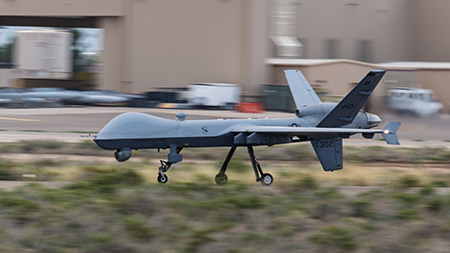
The “low” end of this acquisition strategy was unveiled by Secretary of Defense Pete Hegseth July 10 in a memorandum to senior Pentagon officials on “Unleashing U.S. Military Drone Dominance.” As he indicated, the memo’s aim is to expedite the development, production, and deployment of low-cost drones in massive numbers.
“Drones are the biggest battlefield innovation in a generation,” Hegseth declared in the July 10 memorandum. Yet, “U.S. units are not outfitted with the lethal small drones the modern battlefield requires.”
To overcome this deficit, he called on the military services to rapidly commence large-scale purchases of such devices from U.S. manufacturers, including from start-up companies with little previous experience working with the Pentagon. “We will bolster the nascent U.S. drone manufacturing base by approving hundreds of American products for purchase by our military,”
he wrote.
To facilitate this process, Hegseth decreed in accompanying instructions that small drones, or unmanned aerial systems, be redefined as “consumable commodities” for procurement purposes, simplifying their acquisition by the military. “Small [unmanned aerial systems] resemble munitions more than high-end airplanes,” he stated. “They should be cheap, rapidly replaceable, and categorized as consumable.”
Apparently, on a separate track, the Pentagon and the military services are developing large, unmanned combat vehicles that are the very opposite of what might be termed “cheap, rapidly replaceable, and … consumable.” These include unmanned surface vessels the size of a small, manned corvette and pilotless jet fighters projected to cost tens of millions of dollars each.
In its budget request for fiscal year 2026, for example, the Defense Department sought $1.1 billion for procurement of the Medium Unmanned Surface Vessel, a pilotless, missile-armed warship with a projected length of up to 200 feet. The Navy already has tested several prototypes of the medium unmanned surface vessel, but it may be several years before production of combat-ready vessels will begin. (See ACT, November 2020.)
The 2026 Pentagon budget request also included $789 million for research and development of the Air Force’s Collaborative Combat Aircraft, an unmanned fighter jet intended to serve as a “loyal wingman” to piloted aircraft on high-risk missions. As envisioned by the Air Force, the collaborative combat aircrafts—each governed by AI-enabled flight controls—will be used to seek out enemy interceptors and air-defense systems and, when authorized by the pilot, engage them on their own.
In April 2024, Secretary of the Air Force Frank Kendall told members of a House Appropriations Committee subcommittee that the Air Force planned to acquire up to 2,000 of the unpiloted aircraft at an estimated cost of $25 million to $30 million each, a program that could cost as much as $60 billion. At that time, the service announced that it had chosen two nontraditional defense contractors, Anduril Industries and General Atomics, neither of which had previously received a major award of this size, to build prototype versions of the collaborative combat aircraft.
A contract award for production of combat-ready CCAs is not expected to be announced until sometime in 2026, but development of the two contending prototypes—General Atomics’s YFQ-42A and Anduril’s YFQ-44A—is proceeding apace. The prototype YFQ-42A underwent its first test flight on Aug. 27, and the YFQ-44A’s first flight is expected shortly, according to Inside Defense.
The Navy, too, has begun development of a collaborative combat aircraft-type “loyal wingman.” On Sept. 5, the service revealed that it had awarded contracts to four contractors—Anduril, Boeing, General Atomics, and Northrop Grumman—for “conceptual designs” for a carrier-based autonomous combat plane. Although expected to be similar in many respects to the Air Force’s collaborative combat design, the Navy variant will be designed to take off and land on aircraft carriers.
The U.S. is seeking to become the world’s premier drone provider instead of ceding that space to China or Turkey.
October 2025
By Shizuka Kuramitsu
The United States has decided to unilaterally reinterpret rules designed to control missile transfers so it can facilitate the sale of drones, the State Department announced Sept. 15.
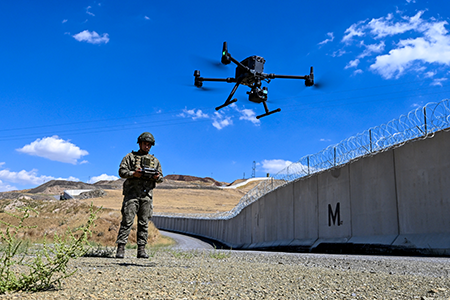
In a statement, the department said that in order to “ensure predictable and reliable delivery of American products to foreign partners, and advance U.S. competitiveness abroad for unmanned systems [it] will now review requests to export [unmanned aerial systems] similar to how it reviews requests to export manned fighter aircraft.”
The new policy will make the United States “the premier drone provider instead of ceding that space to Turkey and China,” a U.S. official, speaking anonymously, told Reuters.
Under the policy, the Trump administration will reinterpret how the United States applies the guidelines set forth by the 1987 Missile Technology Control Regime, which is a voluntary export control regime involving 35 states that seeks to limit the proliferation of missiles and related technology that can carry weapons of mass destruction.
Under the MTCR, exports of Category I systems are subject to a “strong presumption to deny … transfers.” That category includes complete rocket systems and unmanned air vehicle systems that exceeds a range of 300 kilometers and a payload of 500 kilograms.
In a note to key congressional committees Sept. 3, the State Department noted that the change will enable it to “adjudicate foreign defense sales requests more efficiently, opening new markets for the U.S.”
It also asserted that U.S. export controls on missile technology “must keep pace with the speed and scope of technological developments, especially as the use of unmanned systems on the battlefield has become increasingly common for allies and adversaries alike.”
Reuters reported that this new interpretation of the MTCR “would unlock the sale of more than 100 MQ-9 drones to Saudi Arabia, which the kingdom requested in the spring of this year and could be part of a $142 billion arms deal announced in May.” By contrast, the United States “has not been selling or donating large drones to Kyiv for fear that advanced technologies could fall into enemy hands.”
President Donald Trump also revised the MTCR policy in 2020, during his first administration, to expedite sales of unmanned aerial vehicles. (See ACT, September 2020.) The new change “complements recent modifications to the national … MTCR-focused export policy under [the Biden administration’s] National Security Memorandum 28 and advances reforms made under the 2020 Revised UAS Export Policy,” a State Department factsheet said.
At the same time, the department emphasized the U.S. commitment to continue “to ensure its arms transfer review processes are implemented in a manner that does not contribute to the proliferation of weapons of mass destruction or their delivery systems,” and noted that the MTCR “remains an important component of U.S. national security policy.”
The military exercises were less expansive than those before Russia invaded Ukraine in 2002 but still “very aggressive,” the Polish prime minister said.
October 2025
By Xiaodon Liang
The Russian military in September led foreign partners in two sets of scaled-down exercises in Belarus and its own western regions, recalling larger drills that preceded the full-scale invasion of Ukraine in 2022.
Belarusian and Russian troops participated in joint drills Sept. 12-16 as part of Zapad 2025, the latest in a recurring series of quadrennial exercises.
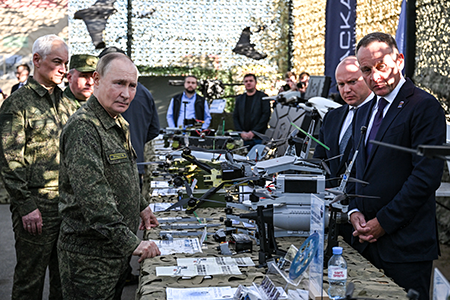 Large-scale Russian military exercises rotate each year across four geographical regions.
Large-scale Russian military exercises rotate each year across four geographical regions.
Although Russian President Vladimir Putin claimed 100,000 service members were involved, a Lithuanian vice minister of national defense, Tomas Godliauskas, said Aug. 14 that only 30,000 Russian and Belarussian troops were believed to be participating, according to the ELTA news agency.
Some 8,000 troops were on exercises in Belarus, of which only 2,000 were Russian, a Lithuanian intelligence official later added on Lithuanian state television. In 2022, joint exercises masking preparations for the full-scale invasion of Ukraine involved nearly 30,000 Russian troops in Belarus. (See ACT, March 2022.)
Despite the limited scale of the exercises, Polish Prime Minister Donald Tusk described Zapad 2025 as “very aggressive.” Poland held its own large-scale military exercise, named Iron Defender, in September, involving more than 30,000 troops and delegations from NATO allies, including U.S. Army personnel.
Six foreign countries sent military personnel to participate in Zapad 2025, while another 16 sent representatives to observe, the Kremlin said. An Indian contingent of 65 military personnel traveled to Russia for the exercises, TASS reported Sept. 10.
The U.S. military attaché to the embassy in Belarus–which is currently based in Lithuania–was present to observe exercises, a Pentagon spokesperson confirmed to Reuters Sept. 16, a day after the Belarusian Ministry of Defense released a video of two U.S. officers shaking hands with local counterparts on social media.
A week earlier, John Coale, a deputy to U.S. President Donald Trump’s special envoy to Russia and Ukraine, had met with Belarusian President Alexander Lukashenko to deliver a letter from Trump and to announce a deal whereby Belarus would release 52 political prisoners in exchange for the lifting of certain sanctions on its national airline, the Associated Press reported on Sept. 11.
Lukashenko confirmed Sept. 16 that his country’s forces had practiced the launch of tactical nuclear weapons with Russian counterparts as part of Zapad 2025. In a doctrinal shift in November, Russia for the first time explicitly included Belarus under its nuclear umbrella. (See ACT, December 2024.)
The Russian Ministry of Defense released a Sept. 15 video of exercises involving forces equipped with the nuclear-capable Iskander-M short-range ballistic missile system in the exclave of Kaliningrad.
Pavel Muraveiko, chief of staff of the Belarusian armed forces, said the two sides had completed exercises involving the “planning and the consideration of the application of non-strategic nuclear weapons,” and “evaluation and deployment of a mobile missile complex Oreshnik,” state media outlet BelTA reported Sept. 16.
The conventionally armed Oreshnik intermediate-range ballistic missile was first revealed by Russian forces in a Nov. 21, 2024, strike on the Ukrainian city of Dnipro. (See ACT, December 2024.)
From Aug. 31 to Sept. 6, Belarus also hosted a smaller set of military exercises under the auspices of the Collective Security Treaty Organization. Some 2,000 military personnel from Belarus, Kazakhstan, Kyrgyzstan, Russia, and Tajikistan participated, Russian news agency RIA Novosti reported Aug. 31.
Construction Detected at Israeli Nuclear Weapons Site
October 2025
Satellite imagery has revealed construction in progress near the Israeli city of Dimona at the Shimon Peres Negev Nuclear Research Center, a facility that is key to the Israeli nuclear weapons program, the Associated Press reported Sept. 3.
Three of the seven experts whom AP consulted on the images, taken by Planet Labs PBC, assessed that the construction was for a new heavy water reactor. All seven believed that the activity was linked to Israel’s nuclear weapons program.
“It’s probably a reactor—that judgement is circumstantial but that’s the nature of these things,” Jeffrey Lewis, a nuclear expert at the James Martin Center for Nonproliferation Studies told the AP. “It’s very hard to imagine it is anything else.”
The satellite imagery depicts a new structure under construction on a site that previously was deeply excavated in work publicized by the International Panel on Fissile Materials in February 2021. (See ACT, April 2021.) The panel estimated that the excavation began around 2018 or 2019.
Israel denies the existence of a nuclear weapons program and is not a state-party to the nuclear Nonproliferation Treaty. The Federation of American Scientists noted in 2007 that estimates for the Israeli nuclear stockpile range from 70 to 400 warheads, although the lower end of the estimate is likely to be more accurate.
In June 2025, Israel conducted strikes on Iran’s Natanz, Isfahan, and Arak nuclear facilities in an attempt to prevent the country from acquiring a nuclear weapon. (See ACT, July/August 2025.)—LIPI SHETTY
